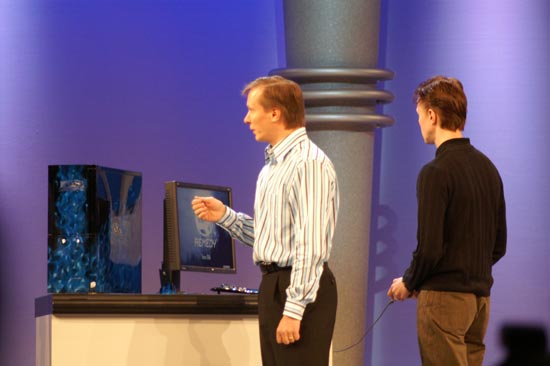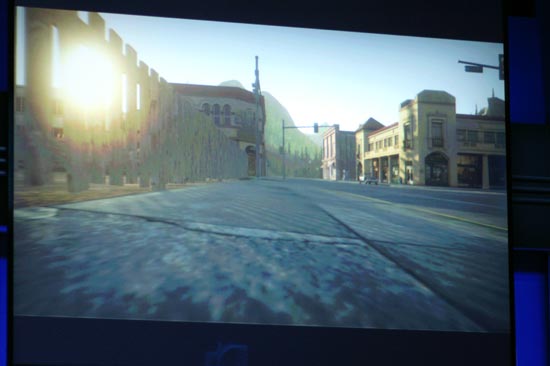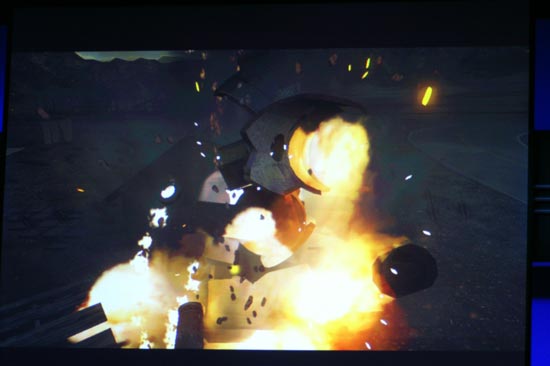Fall IDF 2006 - Day 1: Laser FSBs, more Alan Wake, Flash in Vista & DDR3
by Anand Shimpi & Cara Hamm on September 27, 2006 3:16 AM EST- Posted in
- Trade Shows
More on Alan Wake & Multi-core Gaming
We had a chance to sit down with Markus Maki and Lasse Seppanen of Remedy Entertainment, Ltd. to talk more about their upcoming psychological thriller: Alan Wake.

Alan Wake was demoed during Paul Otellini's keynote on an overclocked Core 2 Quad system running at 3.73GHz, mainly because the game itself is significantly multithreaded and could take advantage of the quad-core system. While development is still continuing on the forthcoming game, we did get some insight into exactly how Alan Wake will utilize multiple cores.
Surprisingly enough, Markus indicated that Alan Wake would pretty much not run on any single core processors, although it may be possible to run on single-core Pentium 4 processors with Hyper Threading enabled, with noticably reduced image quality/experience.
The game will actually spawn five independent threads: one for rendering, audio, streaming, physics and terrain tessellation. The rendering thread is the same as it would be in any game, simply preparing vertices and data to be sent to the GPU for rendering. The audio thread will obviously be used for all audio in the game, although Remedy indicates that it is far from a CPU intensive thread.
The streaming thread will be used to stream data off of the DVD or hard disk as well as decompress the data on the fly. Remedy's goal here is to have a completely seamless transition as you move from one area to the next in Alan Wake's 36 square mile environment, without loading screens/pauses. With Alan Wake being developed simultaneously for both the Xbox 360 and the PC, efficiency is quite high as developing for a console forces a developer to be much more focused than on a PC since you are given limited resources on a console. Markus admitted that being a PC-only developer can easily lead to laziness, and developing for the 360 has improved the efficiency of Alan Wake tremendously. With that said, Markus expects the visual and gameplay experience to be identical on the Xbox 360 and the PC when Alan Wake ships, hopefully without any in-game load screens.

The physics thread will be used to handle all of the game's physics, which is driven using Havoc's physics engine. As Alan Wake uses Havoc's engine, there is no support for AGEIA's PhysX card and thus the host CPU must handle all physics calculations. During the keynote Markus mentioned that the physics thread used an entire core by itself, later clarifying that on a normal Core 2 Quad processor approximately 80% of one core would be used by the physics thread. With 80% of a single core being used for physics alone, the dual core CPU requirement is no longer so shocking.

As a mostly outdoor game, Alan Wake features a tremendous amount of varying terrain that is generated semi-procedurally as you encounter it. The generation/tessellation of the terrain as its encountered occupies the fifth and final thread that Remedy's game spawns. If Remedy can get the game running on Pentium 4 CPUs with HT enabled, it will be with less smooth terrain tessellation (so you may see some popping of terrain) and obviously with fewer physically simulated objects.

Although we are very curious to see how the Cell processor would run Alan Wake, given that Microsoft Game Studios is Remedy's publisher the game's Xbox 360/PC exclusivity needs no explanation. Remedy's Alan Wake team is approximately 30 strong, which is quite lean for a next-generation title, although most artwork is outsourced under the direction of Remedy. Remedy will supply specifications for the art it wants designed, and then hand it off to external art firms that will then produce it to the specs. By outsourcing the artwork, Remedy is able to focus on its development strengths and keep the overall team size down while leveraging the expertise of dedicated artists from around the world.
The demo ran extremely well on the test system, which was a Core 2 Quad running at 3.73GHz with a GeForce 7900 GTX. Markus said that it would have run just as well if the Core 2 Quad was running at its default clock speed, which we assume was 2.66GHz. The game looked even better than when we first saw it at E3 and we eagerly await its release. If Alan Wake is any indication, it won't be long before gamers start thinking about the move to dual/quad core if they haven't already.










16 Comments
View All Comments
drwho9437 - Wednesday, September 27, 2006 - link
"Photonic signaling is in many ways superior to electrical signaling as you can get much higher bandwidths out of an optical bus than you can out of an electrical bus, thanks to photons traveling much faster than electrical fields."Electric signals are photons too. All EM is photons. You are just talking Giga vs Tera freq. This lets you build more ideal wave guides. But that's all. They are both apples.
stepz - Wednesday, September 27, 2006 - link
Electrical bus doesn't signal with electrons, it signals with an electrical field. Individual electrons can take several minutes to get from one pin to another. Optical bus has a bit less latency thanks to photons traveling faster than electric field (around 0.5ns less for a distance of 30cm/1 foot). It has a lot more bandwidth thanks to lack of interference and immense frequency of the carrier signal.
I assume you mean signaling at the board level. It's not practical to use optical signaling at the chip level. Wavelength of the light used is too long for widespread use as chiplevel interconnects.
Caligynemaniac2 - Thursday, September 28, 2006 - link
Actually, optical buses will have more latency than electrical buses. E&M signals propagate in copper wires at ~.9c, while fibre optic cable propagates at ~.6cFurthermore, there will be inherent latency in converting from an optical signal back to an electrical one. What you get with optical interconnects is both increased bandwidth and increased latency.
This may be offset by the ability of serial interfaces to easily revert back to parallel interfaces when coupled with optical rather than electrical signaling (i.e. it is easy to duplex optical signals and essentially impossible for electrical ones- which meant routing was a nightmare for parallel electrical signals as bandwidth needs increased, and will make routing simple for optical signals).
drwho9437 - Wednesday, September 27, 2006 - link
Its all the same all that matters for "speed" of the particle traveling is the characteristic impedance of the waveguide. Signaling bandwidth has to do with how many wiggles you can make EM fields, that is just related to the freq. Now the reason we jump to optical freq after GHz is just because there is no easy way to make the intermediate freq.JarredWalton - Wednesday, September 27, 2006 - link
Electrical fields vs. electrons... what are we, electromagnetic physicists!? ;)The point of silicon photonics is to get light down to the chip level interconnects. It's obviously not there yet. Board level signaling should already be possible, though not generally practical, and of course system level signaling has been optical for a while (server to server fibre optic connections).
VooDooAddict - Wednesday, September 27, 2006 - link
I'm already looking forward to Core 2 Quad. The news that DDR3 support is also right around the corner makes me want to wait a little longer for DDR3 and the added bandwidth and 1:1 FSB to Memory Clock.Sunrise089 - Wednesday, September 27, 2006 - link
While actually having a highly multi-threaded game will be nice, until much more specific performance info is available I see little reason why "gamers [will] start thinking about the move to dual/quad core if they haven't already."Several problems stand in the way of quad core being ideal for gaming:
1) Anandtech itself reported how difficult it was for a game developer to make their games trully multithreaded, so it remains to be seen how many games actually have the degree of threading present it Alan Wake.
2) The publisher only quoted actual performance use of the physics thread (80% of a standard clocked C2Duo), so it's VERY possible if the other threads use substantially less processing power the four cores may not be trully needed.
3) Even in this game, the publisher itsself admits that simply overclocking the dual-core machine allows for equal performance compared to the stock quad-core, so raw power seems to be trully important, not a specific number of cores.
4) The most important performance increase will always be from one core to two, since the overhead of the OS, antivirus program, etc can be removed from the primary game thread. After that, each additional core will suffer from deminished returns
5) Most importantly, going from dual to quad core costs money, and if the past is any indication, that mnoey should be better spent on a GPU upgrade. In fact, with the near theoritical doubling of performance with dual core over single, the GPU upgrade is probably reletively a better idea than it's ever been.
Until these issues are resolved I think while the game may be impressive, the idea that gamers will want to jump to quad-core is mostly marketing derived.
Anemone - Wednesday, September 27, 2006 - link
I find it disturbing that there isn't much comparison of that same Alan Wake game on a Core 2 duo. I do realize that there is a push to highlight the benefits of a quad processor, but are they now making the window for a dual core being the sweet spot to say, just 2007?See, inadvertently, they are likely smashing the sales of core 2 duo's. A lot of folks are wondering if a core 2 duo is going to be "enough" and then for how long will it be enough? Intel has built a lot of "transition" chips over the years and they often have had relatively short useful lives. Is that the reason the Core 2 duo came out so reasonably priced? Is it going to be a small one year chip that is outdated, and potentially badly so, by the end of 2007? If so, why buy one?
Some assurance would have helped a lot if we'd seen a comparison of how Alan Wake, and the benchmark quad processing programs ran on Core 2 duo's. As it is, a lot of folks are getting nervous that they have bought, or might be buying into a dead technology of "just" a dual core.
I sure hope Intel addresses this market concern before they conclude. If not, the holidays could be a very rough season for sales of Core 2 duo's.
JarredWalton - Wednesday, September 27, 2006 - link
It's IDF and Intel is pimping new technology. I would say it's pretty reasonable to assume that quad cores are not at all required. Stating that HyperThreading can run the game with lower detail is also sort of funny, as HT only gives about 10% more performance. Let's see... Athlon 64 single core 4000+ is about 20-30% faster than the best HyperThreading Pentium 4 chips, but HT is enough while a fast single core is not? I don't really buy it, although "enough" seems to be a stretch at best. I will wager that Remedy will work hard to make sure the game at least runs on single core setups, as that is still a very large market segment.Another thought: audio often uses maybe 10-20% of the CPU time in a game. So physics + audio is one core. The streaming and terrain tessellation sounds like maybe half a core at best, and the rendering would probably use the rest of the available power and then some. Remember that Xenon only has 3 cores available, all without OoO execution (Out of Order), so it's reasonable to assume 3 OoO cores will be more than enough, and in fact 2 cores is probably going to be fine.
cmdrdredd - Friday, September 29, 2006 - link
"It's IDF and Intel is pimping new technology. I would say it's pretty reasonable to assume that quad cores are not at all required. Stating that HyperThreading can run the game with lower detail is also sort of funny, as HT only gives about 10% more performance. Let's see... Athlon 64 single core 4000+ is about 20-30% faster than the best HyperThreading Pentium 4 chips, but HT is enough while a fast single core is not? I don't really buy it, although "enough" seems to be a stretch at best. I will wager that Remedy will work hard to make sure the game at least runs on single core setups, as that is still a very large market segment."This is what I think too, they would dig their own grave if they released a game that performed pitifully on a 2.6Ghz single core system. Alot of people still use those HP, and Dell systems their parent's bought them to game on (sometimes with upgraded GPU).
There's no way they can convince me that all 4 cores are needed for any game. I can see 2 because that's becomming mainstream, but to commit suicide by relegating users to abysimal performance is bad news.